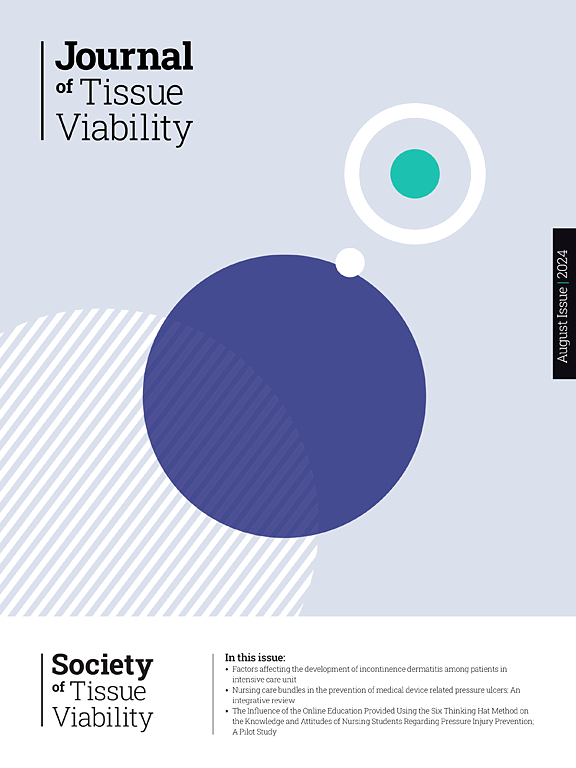The power of empathy: Enhancing healing outcomes in chronic wound care
IF 2.4
3区 医学
Q2 DERMATOLOGY
引用次数: 0
Abstract
Aim
This study explores the impact of healthcare providers’ empathy on patients' healing outcomes and satisfaction in chronic wound care.
Materials and methods
A qualitative descriptive approach was used. Ten adults with chronic wounds were recruited through purposive sampling. Semi-structured interviews were conducted in January 2025, lasting an average of 37.1 min. Data were transcribed verbatim and analyzed thematically using Braun and Clarke's six-phase framework. Rigor was ensured through systematic coding, researcher triangulation, and adherence to COREQ guidelines.
Results
The analysis identified three central themes: (1) The need for person-centered and consistent care, emphasizing the importance of continuity in healthcare providers to reduce emotional exhaustion and improve adherence; (2) The emotional impact of empathy in wound care, demonstrating that empathetic communication raises trust, decreases pain perception, and enhances psychological resilience; and (3) The role of communication, trust, and cultural awareness, highlighting that clear explanations and cultural competence improve patient satisfaction and engagement. Participants who felt listened to and involved in decision-making reported better motivation and adherence to treatment.
Conclusion
Empathy is an important component of effective wound care, influencing healing outcomes, psychological well-being, and treatment adherence. Integrating empathy into clinical practice through continuity of care, shared decision-making, and cultural competence can improve patient satisfaction and overall wound management. Healthcare systems should prioritize training and policies that support empathy-driven, person-centered care.
移情的力量:提高慢性伤口护理的愈合效果
目的探讨医疗服务提供者共情对慢性伤口护理患者愈合结局和满意度的影响。材料与方法采用定性描述方法。通过有目的的抽样,我们招募了10名患有慢性伤口的成年人。半结构化访谈于2025年1月进行,平均持续37.1分钟。数据逐字记录,并使用Braun和Clarke的六阶段框架进行主题分析。通过系统编码、研究者三角测量和遵守COREQ指南来确保严谨性。结果分析确定了三个中心主题:(1)需要以人为本和一致的护理,强调医疗服务提供者连续性的重要性,以减少情绪耗竭和提高依从性;(2)共情在伤口护理中的情绪影响,表明共情沟通提高信任,降低疼痛感知,增强心理弹性;(3)沟通、信任和文化意识的作用,强调清晰的解释和文化能力可以提高患者的满意度和参与度。感觉被倾听并参与决策的参与者报告了更好的动力和对治疗的坚持。结论共情是有效创面护理的重要组成部分,影响愈合效果、心理健康和治疗依从性。通过连续性护理、共同决策和文化能力将移情融入临床实践可以提高患者满意度和整体伤口管理。医疗保健系统应优先考虑支持移情驱动的、以人为本的护理的培训和政策。
本文章由计算机程序翻译,如有差异,请以英文原文为准。
求助全文
约1分钟内获得全文
求助全文
来源期刊

Journal of tissue viability
DERMATOLOGY-NURSING
CiteScore
3.80
自引率
16.00%
发文量
110
审稿时长
>12 weeks
期刊介绍:
The Journal of Tissue Viability is the official publication of the Tissue Viability Society and is a quarterly journal concerned with all aspects of the occurrence and treatment of wounds, ulcers and pressure sores including patient care, pain, nutrition, wound healing, research, prevention, mobility, social problems and management.
The Journal particularly encourages papers covering skin and skin wounds but will consider articles that discuss injury in any tissue. Articles that stress the multi-professional nature of tissue viability are especially welcome. We seek to encourage new authors as well as well-established contributors to the field - one aim of the journal is to enable all participants in tissue viability to share information with colleagues.
 求助内容:
求助内容: 应助结果提醒方式:
应助结果提醒方式:


